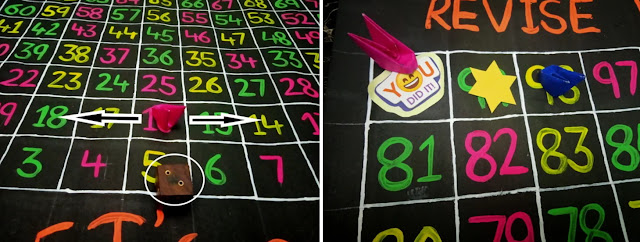Let’s face it, sometimes revision can be boring and it’s difficult for kids to motivate themselves.
By the time students get to the end of term, their interest in preparing for exams can usually need some help.
Today, I'll be sharing a revision activity for the classroom/home that can be used to help kids revise for exams with some fun before they do their exams.
Using Games as a revision strategy not only makes it fun but also helps:
1) To develop an enthusiastic learner.
2) To motivate and engage students.
3) Reduce monotonous learning methods.
4) To help students with focus, self-esteem, and memory.
5) They can foster whole-class participation.
6) Games build class cohesion.
7) Games promote healthy competition
Inspired by Snakes and Ladder board game, this game will make kids love to revise.
Things We Need
Chart Paper (I used Black color)
Sketch pens/Watercolor of your choice
Dice
Game pieces/tokens
A4 Sheet and Pen
Preparations(1/2)
1) As shown in the picture above, make 100 equal size square grids on the chart paper. Marks them from 1 to 100, starting from the bottom left corner of the chart paper. After numbering a whole row, move one square up to continue numbering.
Decorate it, make it colourful, add stickers if you like(Kids will love it)
2) Cut out some stars and hearts from an A4 sheet. Colour them. The colour of the heart should match the colour of the token/piece of the teams.
3) Using another A4 sheet, cut out ten 2x2 inch squares. Write the following on them:
On two of them write: Extra Life +1
On another two, write: Skip a chance
On another two, write: Move 5 grids forward
On another two write: Move 3 grids backwards
Fold them and put them in a bowl.
Preparations(2/2)
1) For a team game place 2 hearts per team on grid num 25. For solo/single-player game place 1 heart per player. The color of the heart should match the color of the token/piece of the teams.
2) Place stars on grid number 6, 43, 74 and 99.
How to Play(1/3)
Before the game can start each player will roll one dice, the player who throws the highest number will be the one to have the first turn.
The players will move their pieces/token from left to right, starting at 1, following the numbers on the board, then the next row from right to left and repeat.
How to Play(2/3)
The player has to answer a question before rolling the dice. Depending on his response, the player will move as many boxes/grids forward or backward as he gets after rolling the dice.
The first player that reaches the highest space on the board, 100, wins the game. However, to win the player will need to roll the exact number to get you to the last space. If the player rolls a higher number than needed to land exactly on 100, their piece does not move and remains there until their next turn, when they can roll again.
How to Play(3/3)
Once a player/team crosses grid number 25, they can collect heart corresponding to their piece/token. This will fetch then extra life(explained below). For a team game, there will be 2 lifelines and for solo player game there will be only one lifeline.
If player's token/piece lands on any of the STARS, they get the chance to pick a chit from the bowl. The players have to perform the task written on the chit.
Rules: for a Team Game
Make sure each team has an equal number of players.
Form box 1 to 25
Here, the question asked will be Multiple Choice(MCQ).
In case of the correct response, the team will move as many boxes forward as he gets after rolling the dice. In case of an incorrect response, the team will lose one of its members(to be decided by the teammates). on reaching the box 25, the teams will get 2 lifelines.which can be exchanged to revive their teammates or they can save it for the later stages of the game.
From box 26 to 75
Questions asked will be Lower order thinking Skills(LOTS) based.
Depending on his response, the players will move as many boxes/grid forward or backward as they get after rolling the dice.
From box 76 to 100
Questions asked will be Higher order thinking skills(HOTS) based.
Rules: for Single/Solo Player Game
Form box 1 to 25
Here, the question asked will be Multiple Choice(MCQ).
The player has to answer a question before rolling the dice. In case of the correct response, the player will move as many boxes/grids forward as he gets after rolling the dice. If the response is incorrect, the player will move as many boxes/grids backward as he gets after rolling the dice.
From box 26 to 75
Questions asked will be Lower order thinking Skills(LOTS) based.
In case of the correct response, the player will move as many boxes forward as he gets after rolling the dice. In case of an incorrect response, to continue the game, the player has to exchange the heart(collected at grid 25), failing which he loses the game.
From box 76 to 100
Questions asked will be Higher order thinking skills(HOTS) based.
Thank you for your time. Please Vote my Instructable if you liked it.



Comments
Post a Comment